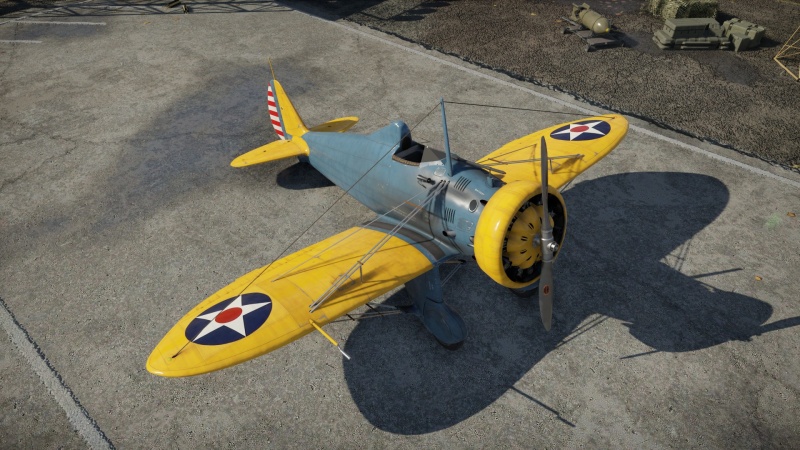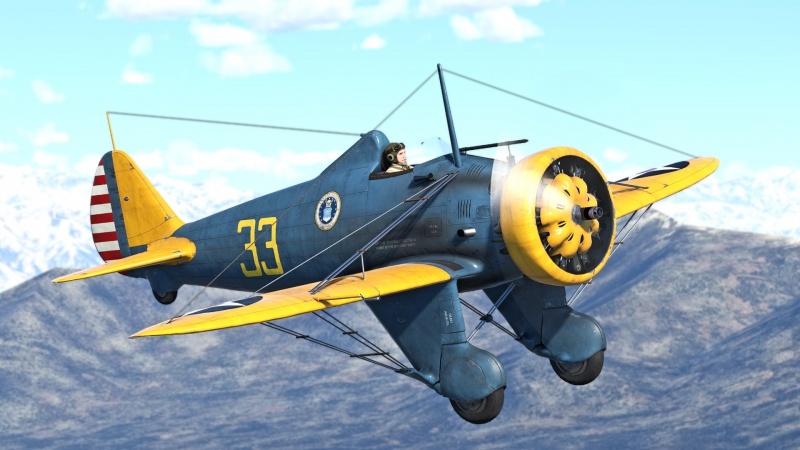P-26A-33
| This page is about the American fighter P-26A-33. For other versions, see P-26 (Family). |
Contents
Description
The P-26A-33 Peashooter is a rank American fighter with a battle rating of (AB), (RB), and (SB). It has been in the game since the start of the Open Beta Test prior to Update 1.27.
First funded in 1931 by Boeing, the P-26 Peashooter was ordered by the US Army Air Corps to assist as a monoplane fighter. Early prototypes flown in 1932 had one fatal flaw: the landing speed. The landing speed was too high and it would cause gear failure, leading to crashes. Later models of the P-26 had landing flaps to combat this. The P-26 was designed to be faster and more manoeuvrable than the current biplanes. When WW2 broke out, the P-26 was exported to some of the Allies of the USA, and they were still in use when the USA entered the war in 1941. In 1956, the final pair of P-26 Peashooters were taken out of service and replaced by P-51 Mustangs, therefore retiring the P-26 Peashooter. This air frame was used for nearly 25 years.
General info
Flight performance
| Characteristics | Max Speed (km/h at 2,286 m) |
Max altitude (metres) |
Turn time (seconds) |
Rate of climb (metres/second) |
Take-off run (metres) | |||
|---|---|---|---|---|---|---|---|---|
| AB | RB | AB | RB | AB | RB | |||
| Stock | 367 | 357 | 18.6 | 19.6 | 9.2 | 9.2 | 170 | |
| Upgraded | 384 | 377 | 17.7 | 18.0 | 16.0 | 12.0 | ||
Details
| Features | ||||
|---|---|---|---|---|
| Combat flaps | Take-off flaps | Landing flaps | Air brakes | Arrestor gear |
| X | X | X | X | X |
| Limits | ||||||
|---|---|---|---|---|---|---|
| Wings (km/h) | Gear (km/h) | Flaps (km/h) | Max Static G | |||
| Combat | Take-off | Landing | + | - | ||
| N/A | N/A | N/A | ~12 | ~8 | ||
| Optimal velocities (km/h) | |||
|---|---|---|---|
| Ailerons | Rudder | Elevators | Radiator |
| < 260 | < 180 | < 340 | > 190 |
| Compressor (RB/SB) | ||
|---|---|---|
| Setting 1 | ||
| Optimal altitude | 100% Engine power | WEP Engine power |
| 1,829 m | 600 hp | N/A |
Survivability and armour
- No armour
- Self-sealing fuel tanks (1 under pilot, 1 in each wing)
The P-26 is a typical mid-1930s design, and just like all of its contemporaries (other reserve fighters) it does not have pilot armour, but, is upgraded with self-sealing fuel tanks. Pilot, engine, and fuel are centrally located, but its simple design (no flaps and retractable gear) has less that could be damaged. Although a monoplane its speed is average to other reserve fighters, and do not dare turn fight. One major advantage is the excellent visibility from the cockpit to easily spot threats during simulator battles.
Modifications and economy
On this early tier of aircraft any upgrade is valuable and easy to come by. In general "Engine" and "Compressor" are good upgrades, likewise for the "Offensive 7 mm belts" and "New 7 mm MGs" unlocks.
Armaments
Offensive armament
The P-26A-33 is armed with:
- 2 x 7.62 mm Browning machine guns, nose-mounted (500 rpg = 1,000 total)
Suspended armament
The P-26A-33 can be outfitted with the following ordnance:
- Without load
- 2 x 100 lb AN-M30A1 bombs (200 lb total)
Usage in battles
Like most US fighters, the P-26A-33 Peashooter is a decent energy fighter even though its high lift creates unstable diving characteristics. Despite being a monoplane, the P-26 is not the fastest reserve fighter. In most regards the P-26A-33 will be outmatched by enemy fighters; for example, the Japanese Ki-10s will not only turn circles around the P-26A-33 but will out-climb it and out-run it too. However, the slow German He 51 makes an easy target for a P-26A. P-26 pilots should instead focus on attacking and harassing enemy bombers.
Unlike the P-26A-34 M2, the P-26A-33 does not have a 12.7 mm (.50 cal) machine gun. Because both fighters are available at the same time and identical in all other regards, this makes the P-26A-34 M2 the clearly superior choice. The P-26A-33 should be reserved for Arcade Battles as a backup.
Manual Engine Control
| MEC elements | ||||||
|---|---|---|---|---|---|---|
| Mixer | Pitch | Radiator | Supercharger | Turbocharger | ||
| Oil | Water | Type | ||||
| Not controllable | Not controllable Not auto controlled |
Not controllable Not auto controlled |
Not controllable Not auto controlled |
Separate | Not controllable 1 gear |
Not controllable |
Pros and cons
Pros:
- Fairly good speed, for a reserve plane
- Stable turning
Cons:
- Slower than some late biplanes
- No armour
- Poor dive characteristics
- Poor energy retention
History
The Boeing P-26 Peashooter was a plane both ahead of its time and quickly made obsolete. First flown in 1932, the P-26 is the oldest plane in the game. It was one of the first all-metal monoplanes adopted into military service in 1933 (in comparison, the He 51 and Ki-10 entered service in 1935), making it one of the fastest fighters in the world at the time, but it suffered from poor flight performance and dangerous landing characteristics. However, as newer fighters entered service around the world, the P-26s advantages diminished and its disadvantages became vulnerabilities. By the time of World War Two, the P-26 was hopelessly obsolete.
The P-26 saw the most of its combat serving in the Chinese Nationalist Air Force during the Second Sino-Japanese War, against Japanese Ki-10s, and notably A5Ms in some of the first all-metal monoplane dogfights. Although it performed admirably in the pursuit role (bomber interception), in air-to-air combat with Japanese fighters, the deficiencies of the model showed.
In US service, the P-26 had a similar record. During the Japanese invasion of the Philippines, the P-26s scored only a handful of air-to-air kills against Japanese attackers. On December 24, 1941, their crews burnt the remaining planes to prevent their capture. Of the one hundred and fifty-one built, only nine airworthy P-26s remained by Christmas 1941, a single squadron defending the Panama Canal Zone, which was removed from service shortly after.
In addition to several replicas, two original aircraft still survive today, including one (serial no 33-123) which has been restored to flying condition.
| Archive of the in-game description | |
|---|---|
|
A single-seat, all-metal braced monoplane fighter with an open cockpit and non-retractable landing gear in its fairings. It was designed by the design office of the Boeing Company. The XP-936 (Model 248) prototype made its first flight on 20 March 1932. The aircraft was accepted for service with the USAAC under the designation of P-26A. Full-scale production was started at the Boeing plant in Seattle in December 1933. The first production P-26A (Model 266) got off the ground in January 1934. The P-26A had a 550 hp Pratt & Whitney R-1340-27 nine-cylinder, air-cooled engine equipped with a Hamilton Standard two-bladed, controllable-pitch metal propeller. The P-26A's armament consisted of two synchronous 7.62 mm Browning M1 machine guns with 500 rounds each. The machine guns were mounted below the forward fuselage, and they fired through the arc of the spinning propeller. A C-3 gun sight was fitted in front of the cockpit. A G-4 gun camera could be installed over the right wing's centre section. Under the centre wing sections, an A-3 bomb rack that could carry either two 100 lb (45 kg) high-explosive bombs or five 30 lb (14 kg) fragmentation bombs could be mounted. Externally, production P-26As differed from prototype machines in their wing panels with elliptical tips and short landing gear fairings. Changes were introduced into the wing design, and a radio set was installed. An antenna mast was mounted on the starboard side, in front of the cockpit. The first P-26A fighters were transferred to the 20th Fighter Group located at Barksdale Air Force Base, Louisiana. The P-26 was nicknamed the Peashooter by pilots. Operational pilots praised the fighter's great flight characteristics, such as its rate of climb and excellent manoeuvrability. Pilot complaints included poor forward visibility during taxiing and takeoff, as well as by landing difficulties. Taxiing out to the start line in the S-curve became a standard Peashooter manoeuvre to reduce the takeoff accident rate. | |
Media
- Skins
See also
- Related development
- Aircraft of comparable role, configuration and era
External links
| Boeing Aircraft | |
|---|---|
| Aircraft | |
| Fighters | P-26A-33 · P-26A-34 M2 · P-26B-35 |
| Bombers | B-17E · B-17E/L · B-17G-60-VE |
| B-29A-BN | |
| Export | P-26A-34 · B-17G |
| Captured | ▅B-17E |
| Helicopters | |
| Attack | AH-64A · AH-64D |
| Export / Licensed | AH-64A (GR) · ▃AH-64A Peten · AH-64A Peten · ▅AH-64DJP · ▄AH Mk.1 · AHS |
| See Also | Tupolev Design Bureau · Westland Helicopters · Fuji Heavy Industries |
| For Boeing-built ships, see Boeing Marine Branch | |
| USA fighters | |
|---|---|
| P-26 Peashooter | P-26A-33 · P-26A-34 · P-26A-34 M2 · P-26B-35 |
| P-36 Hawk | P-36A · Rasmussen's P-36A · P-36C · ○P-36C · P-36G |
| P-39 Airacobra | P-400 · P-39N-0 · P-39Q-5 |
| P-40 | P-40C · P-40E-1 · P-40E-1 TD · P-40F-10 |
| P-43 Lancer | P-43A-1 |
| P-47 Thunderbolt | P-47D-22-RE · P-47D-25 · P-47D-28 · P-47M-1-RE · ⋠P-47M-1-RE · P-47N-15 |
| P-51 Mustang | P-51 · P-51A (Thunder League) · P-51C-10 · P-51D-5 · P-51D-10 · P-51D-20-NA · P-51D-30 · P-51H-5-NA |
| P-63 Kingcobra | P-63A-5 · P-63A-10 · P-63C-5 · ␠Kingcobra |
| Prototypes | XP-55 |
| F2A Buffalo | F2A-1 · Thach's F2A-1 · F2A-3 |
| BF2C | BF2C-1 |
| F3F | F3F-2 · Galer's F3F-2 |
| F4F Wildcat | F4F-3 · F4F-4 |
| F4U Corsair | F4U-1A · F4U-1A (USMC) · F4U-1D · F4U-1C · F4U-4 · F4U-4B · F4U-4B VMF-214 · F2G-1 |
| F6F Hellcat | F6F-5 · F6F-5N |
| F8F Bearcat | F8F-1 · F8F-1B |
| Other countries | ▃Ki-43-II · ▃Ki-61-Ib · ▃A6M2 · ▃Bf 109 F-4 · ▃Fw 190 A-8 · ▃Spitfire LF Mk IXc |






